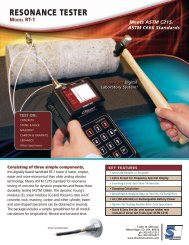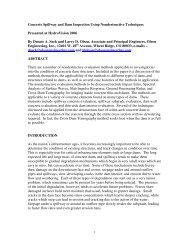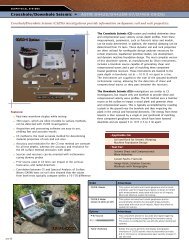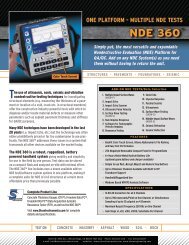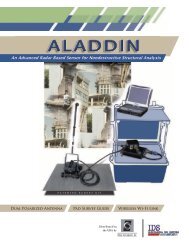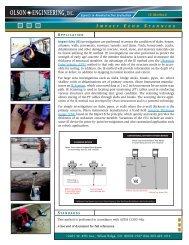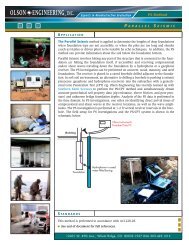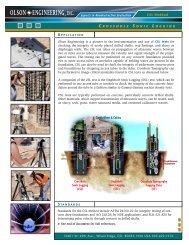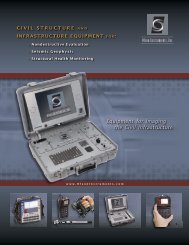OI Catalog - Olson Instruments, Inc.
OI Catalog - Olson Instruments, Inc.
OI Catalog - Olson Instruments, Inc.
Create successful ePaper yourself
Turn your PDF publications into a flip-book with our unique Google optimized e-Paper software.
Geophysical Systems<br />
Crosshole/Downhole Seismic » ASTM D4428/D4428M-07/D7400-08(DS)<br />
Method<br />
The CS investigation requires drilling of two or more (ideally<br />
three) boreholes cased with PVC or slope inclinometer casing<br />
for deeper borings up to 328 ft (100 m), and grouted in<br />
accordance with ASTM standards to ensure good<br />
transmission of wave energy. The boreholes are typically 4-6<br />
inches in diameter cased with 2.32 to 3 inch (59 to 76 mm)<br />
I.D. casing, not to exceed 4 inches (102 mm) I.D. The testing<br />
is simplified if inclinometer casing is used rather than normal<br />
PVC pipe. Typical distances between adjacent in-line<br />
boreholes are on the order of 10 ft (3 m). The testing is<br />
performed by lowering both the source and receiver(s) to an<br />
investigation depth, firing the source, and recording the<br />
energy with the receivers.<br />
The DS investigation requires drilling a single borehole<br />
with similar specifications as listed above, except that only<br />
a single grouted 2 inch (50 mm) to 3 inch (76 mm) I.D. PVC<br />
casing is needed, not to exceed 4 inches (102 mmm) I.D.<br />
The testing is performed by lowering the receiver(s) to an<br />
investigation depth, impacting the coupled surface plank,<br />
and recording the energy with the receivers.<br />
All of the CS/DS Models<br />
are compatible with <strong>Olson</strong><br />
Instrument’s P-SV Source.<br />
This component provides<br />
the user with the most<br />
accurate and rapid method<br />
of generating impacts.<br />
Dummy<br />
Probe<br />
Optional<br />
P-SV Source Receiver 1<br />
Triple Port<br />
Manifold<br />
SV<br />
P<br />
Dummy<br />
Probes<br />
SV<br />
Optional<br />
Receiver 2<br />
P<br />
Triaxial<br />
Geophone<br />
Receivers<br />
Data Collection<br />
The user friendly CS/DS software is written and tested at <strong>Olson</strong><br />
<strong>Instruments</strong>’ corporate office in Colorado. We do not outsource<br />
any tech support questions and, should you require software<br />
support, we welcome your questions and comments.<br />
Data Example » 1<br />
Available Models<br />
The Crosshole/Downhole Seismic system is available in<br />
two different models with an optional P-SV Source. All<br />
systems require the <strong>Olson</strong> <strong>Instruments</strong> Freedom Data PC<br />
platform for testing:<br />
1. Crosshole/Downhole Seismic - 1 (CS/DS-1)<br />
2. Crosshole/Downhole Seismic - 2 (CS/DS-2)<br />
The CS/DS -1 Model is the base model for Crosshole<br />
or Downhole Seismic testing. This system includes one<br />
triaxial geophone and one accelerometer allowing for<br />
direct path measurements associated with each set of<br />
impacts, either in the borehole if a downhole source is<br />
used (CS) or on the surface if a downhole source is not<br />
used (DS). Specifically, this system can be used to test the<br />
material between the impact and the receiver’s location in<br />
the borehole.<br />
The CS/DS -2 Model includes two geophones and an<br />
accelerometer allowing for dual path measurements<br />
associated with each set of impacts, either in the borehole<br />
or on the surface. Specifically, this system can be used to<br />
test the material between the impact and the receivers’<br />
location in the borehole(s). This DS-2 system performs the<br />
Freedom Data PC Required,<br />
Sold Separately<br />
Screen shot from an <strong>Olson</strong> <strong>Instruments</strong> Freedom Data PC showing a<br />
waveform recorded during a Crosshole Seismic test.<br />
geo-37




